City Staffers Brief Wall Street Neighbors
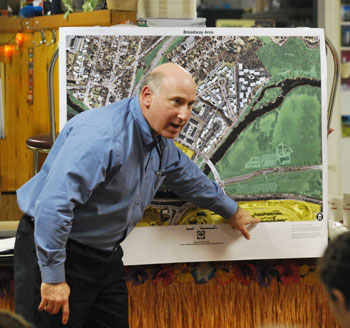
Eli Cooper, transportation program manager with the city of Ann Arbor, discusses the possible location of a transit center nestled between Fuller Road and East Medical Center Drive, just east of Fuller & Maiden Lane.
On Tuesday evening, way after hours at Northside Grill, a collection of city staff and city councilmembers met with around 40 residents to discuss the relationship of the University of Michigan with the city of Ann Arbor – both generally and with specific regard to the proposed UM expansion along Wall Street.
That construction is currently proposed to include an office building, parking structure and transit center. It was not news to neighbors that UM plays by a different set of rules (its own). What could have been a revelation were the general mechanisms by which city staff work in an environment where they can attempt to nudge UM to adhere to the vision outlined in the city’s planning documents – documents that were created with participation of UM staff.
So there were no magic bullets offered that could kill the parking structure component of the current UM Wall Street expansion. But the vision of a possible transit station along Fuller Road, which would include a substantial number of parking spaces serving a variety of needs, was held out as a possibility that could attract the university away from building more parking along Wall Street. That potential transit station would be nestled between Fuller Road and East Medical Center Drive, just east of Fuller & Maiden Lane.
How the City Works with UM
Craig Hupy, head of systems planning with the city of Ann Arbor, outlined for residents why the University of Michigan does not need to adhere to city-level or state-level ordinances and statutes (with respect to zoning or anything else): UM is a state constitutional entity, and as such, whatever the university does on its land is its choice. One example cited by Hupy of the disconnect between administrative control and practical consequence is the university’s fire code standards, which are administered by its own fire marshall – but the fires themselves are fought by the city of Ann Arbor.
Where the city does have some very limited leverage, said Hupy, is when the university needs access to the public right of way, which is administered (not owned) by the city of Ann Arbor: utility connections and driveway permits, for example. But here the city does not have the latitude to deny use of the right of way as a strategy for bargaining on unrelated matters. The city can simply require that the right of way is used in a manner consistent with the conditions required of any entity (including the university).
In that context, Wendy Rampson and Mark Lloyd, planners with the city of Ann Arbor, described how city staff from planning and development services and systems planning meet with university planning staff on a roughly once-a-month basis. The point of the meetings is to work through technical details. And, said Rampson, staff attempts to “influence even if we cannot require” the university to take paths more consistent with existing city planning documents.
Asked to what extent the city could prevent the university from building parking structures based on the impact to traffic, Rampson said that the city did not have the sort of leverage they had with a private developer, where approval of the project’s site plan could depend on a demonstration that traffic patterns would not be disrupted. In the case of university parking structures, the city could require infrastructure improvements in terms of widening roads or improved signaling, but the city didn’t have the ability to kill a university project on that basis. The impact on air quality was handled on a regional level, said Rampson.
A pointed question from the audience: “How often do you say to them, ‘This conflicts with the North East Area Plan’?” Rampson’s answer: Often. She characterized the monthly meetings as “frank.”
But the focus of the monthly meetings to work out technical details is on projects already in the works. And residents wanted to know to what extent city of Ann Arbor staff are included in the university’s conceptual planning – before a project is brought before the Board of Regents for approval. Rampson described how there is a sense among university planning staff that a project does not exist until it has been approved by the Board of Regents. This made them reluctant to talk about projects when they are in their nascent, conceptual stages. [This is consistent with the repeated emphasis of the phrase "regentally approved project" at a previous meeting between university staff and residents on the Wall Street expansion.]
In fact, when asked when the university began the conceptual planning for the Wall Street expansion, Rampson said, it was not clear when that might have been. At the point when the city’s Northeast Area Plan was adopted, which included participation from UM staff, Rampson said that there was no indication that the university wanted to build parking decks along Wall Street.
“The Regents are Oblivious”
Residents expressed the desire for the university to include not just city staff, but also ordinary citizens of Ann Arbor, in its conceptual planning process. Residents also expressed the sentiment that regents have little sense of the impact the university’s construction projects have on the Ann Arbor community. “The regents are oblivious,” said one voice in the audience.
Stephen Rapundalo, who was joined at Northside Grill by fellow city councilmembers Sabra Briere (who had asked for that evening’s meeting to take place) and Sandi Smith, said that the desire of greater participation by the city in university planning had been communicated to individual regents: “We have expressed the desire you have articulated.” But Rapundalo characterized the general approach of the university’s interaction with the city this way: “They come in and they lecture you.”
Some amount of frustration surfaced throughout the meeting on Tuesday evening and was reflected in the question from one audience member: “Are we going to lie down and let this happen?”
The meeting concluded with the expression of one woman in the audience of a wish for greater participation from citizens – but ultimately it was the city’s elected representatives who needed to bring specific proposals to the regents, she said. And if 100 residents needed to show up to the regents’ meeting to support them as they did that, then that’s what they would do.
Fuller Road Multi-Modal Transit Center
One of the specific proposals on the city’s side that residents wanted communicated more clearly to the university is the vision of a multi-modal transit center nestled between Fuller Road and East Medical Center Drive. The university has expressed interest, said Rampson, but is still proceeding on a parallel track to build more parking on Wall Street. The Fuller Road transit center’s relation to the university’s regentally-approved Wall Street expansion is that it would relieve some of the pressure to build parking along Wall Street that does not serve medical facilities on Wall Street itself.
This is the source of much of the resistance expressed among residents to the planned parking structures – the university’s planned structures are meant in part to serve patients on other parts of the medical campus. This, as one resident put it, is the worst of both worlds: (i) the location is far enough away from the clinical facilities that it requires a shuttle bus, and (ii) it’s close enough to central Ann Arbor to cause congestion.
Eli Cooper, transportation program manager for the city of Ann Arbor, showed a sketch (prepared in-house by city of Ann Arbor staff) of what the footprint of a multi-modal transit station along Fuller Road could be like. He cast the station in the context of an overall transportation planning context that includes east-west commuter rail, north-south commuter rail, and some kind of high-capacity circulator within the city of Ann Arbor. Why do we need all this transportation? Part of Cooper’s answer had to do with one projection that sees the addition of 20,000 jobs over the next 25 years in the Ann Arbor area – a projection based on the two growth areas of higher education and health care.
As the western terminus of a possible east-west commuter rail corridor between the Detroit area and Ann Arbor, the Fuller Road transit station would, said Cooper, create demand for parking from people living to the north, the south, and further west, who would be driving to the station to get access. The Fuller Road transit station would include some 800 parking spaces to serve a range of different users – from university medical center patients to commuters. Cooper said that he’d had two phone conversations with Amtrak about the possibility of consolidating the Amtrak station (now located on Depot Street below the Broadway Bridge) with a Fuller Road transit station.
There were two questions about the siting of the Fuller Road transit station. One had to do with the possible restrictions on use of the land based on its history as a donated parcel. Cooper said that a preliminary look by the city attorney’s staff suggested that there were no encumbrances on the land. The second had to do with the environmental impact on the watershed, and where it sat with respect to the floodway. Cooper said that in terms of impervious surface, a transit station would be no worse than the surface parking lot currently at the site, which lies outside the floodway.
How soon can we expect to see east-west commuter rail? Cooper said fall 2010 is the target demonstration date for the project, which is being managed by SEMCOG and MDOT.




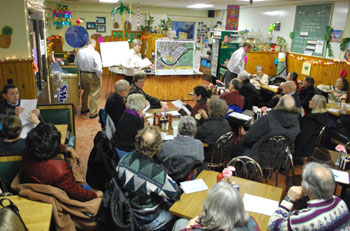

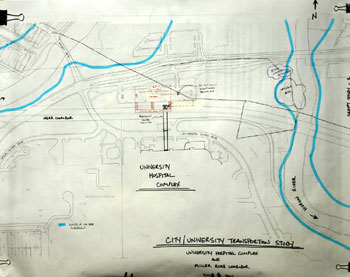

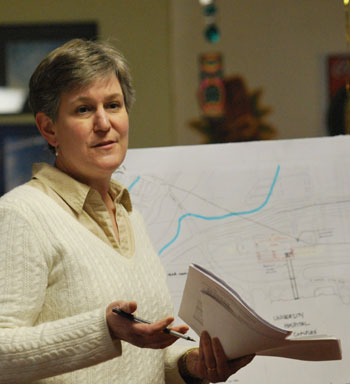
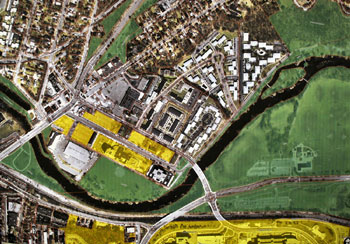
i don’t think i understand what the big deal is…
…the parking structure(s) will create a lot of traffic? to begin with, wall street isn’t a busy road. also, it’s not a dense, residential neighborhood where a parking structure and any increase in traffic that it would bring, would be problematic. maiden lane is a busier street but will always remain that way as it is a corridor that connects fuller to broadway/plymouth road and also pontiac trail.
i’m not sure what is meant by central ann arbor either. are they thinking that hordes of people would park down on wall street so they can shop and dine downtown? that they would park there and walk to some residences on the other side of the tracks and over a bridge? i seriously doubt that. people who will use the structure(s) will use it for the immediate area and i don’t think there’s any worry that it would attract even more people who would use it but venture off well outside the area.
as for the shuttles, that’s true. it would entail shuttles. although i would hazzard a guess that a lot of people wouldn’t mind a short walk to the med center. i already see a lot of employees doing that. visitors, however, will most likely use the shuttles. and guess what? there’s already an existing shuttle route for wall street. so nothing new there.
so, um has land and the money to build and in so doing, create jobs for contractors, skilled laborers, general laborers, architecture firms, and the like. sounds like a plus to me. the med system employs thousands of people. another plus. if they want to put up these projects… on their own land… GOD BLESS ‘EM! at least we can count on um to weather through these economic hard times.
so many people are quick to jump down the university’s throat. i think that’s the way it always is… any large entity must be evil. let’s take ‘em down! a lot of citizenry were up in arms over um purchasing the pfizer land taking tax money away from the city. guess what? nothing was happening with that parcel. no big takers, especially not now during this downturn. if um didn’t take it off the city’s hands, it would have ended up like the lower town project. years of nothing with ocassional glimpses of hope. so, they buy it with a definitive plan and the prospects of increasing the jobs base in the region. sounds good to me. i’m sure the businesses across the road will enjoy having some neighbors around again. and another thing, um originally owned a majority of that land. they sold it in the 1950s to parke davis which became pfizer. and then they sold them additional land when pfizer needed to expand with the agreement that um had the right to purchase should pfizer sell off. so, where were the: hoorays!!! for michigan for fifty years when the city was reaping property takes from parke davis and pfizer courtesy of um selling the property? no, i didn’t hear it then and i don’t hear it now. really, it’s their land, they should do what they want with it… parking structures on wall street, labs on pfizer.
the university brings a lot to this city. it isn’t the evil entity that people like to think. it brings in people who work, live and play here. it brings in art and culture. thank god for umma, huh? a city of 100,000 without a museum? wow, that would suck. the nat sci museum, kelsey museum… fantastic, huh? would the royal shakespeare company come to ann arbor if not for the university? all the musical, theater, and performance troupes and groups that come to ann arbor… guess what? courtesy of the university. the energy and excitement, the desire to try new things, creativity, thoughtfulness, get up and go… students, staff, visitors, infected townies. without the university and it’s building projects and expansions, this landscape would be a more barer and poorer one to live in… we’d be nothing more than a canton or a brighton or a livonia. maybe not even that considering we’re well past the suburban detroit ring.
so, people… quit yer bitchin’. it sounds like people have got their panties in a bunch because they feel slighted by the university. you don’t like it here? you don’t like the university? that’s ok… just move to howell so we don’t have to hear you anymore.
You said it all, Montel.
That’s correct, Montel, you don’t understand what the big deal is.
-
A few examples:
-
“…the parking structure(s) will create a lot of traffic?”
– Yes. UM’s own traffic analysis concluded that peak weekday traffic rate on Wall Street would increase from currently less than 200 cars/hour to well over 1000 cars/hour.
-
“to begin with, wall street isn’t a busy road.”
– The parking structure will also be immediately adjacent to Maiden Lane which is already jammed during rush hours. Worse, the only access to Wall Street itself from the east is via Maiden Lane.
-
“i’m not sure what is meant by central ann arbor either.”
– Well, at least you admit it. Central Ann Arbor is the area, in & around the center of the City, that has a high population density and a high density of pedestrians and vehicular traffic congestion. It’s also the area of the City with the highest air pollution concentrations of unburned hydrocarbons, oxides of nitrogen, carbon monoxide, and micro- & nanoscopic organic particulates. (The Wall Street/Lower Town area in particular is one of the most vulnerable areas in the City for air pollution because it’s in a valley and because of the high traffic flow through the area on Broadway and on Maiden Lane — not to mention the traffic through Fuller’s intersection with Maiden Lane immediately east of the Wall Street area.)
One of the most effective ways that other cities have restrained increases in these air pollutants has been to reduce single-occupancy vehicle (SOV) traffic in city centers.
-
“are they thinking that hordes of people would park down on wall street so they can shop and dine downtown? that they would park there and walk to some residences on the other side of the tracks and over a bridge?”
– Neither. The structures (two, with 600 parking spaces each) are planned entirely for UM Hospital employees and patients, and mostly for UM employees.
-
“visitors, however, will most likely use the shuttles. and guess what? there’s already an existing shuttle route for wall street. so nothing new there.”
– What’s new are shuttles to accommodate commuters using the 1200 additional parking spaces. The currently proposed Wall Street/Maiden Lane location for this new parking capacity is the WORST POSSIBLE location: It’s just far enough away from the Hospital’s main campus to require most users first to park and then to take a shuttle, yet it’s so close to the main campus that use of the new parking capacity will have virtually no effect on restraining the increase in SOV mileage accumulated in the central City.
-
“so, um has land and the money to build and in so doing, create jobs for contractors, skilled laborers, general laborers, architecture firms, and the like. sounds like a plus to me. the med system employs thousands of people. another plus. if they want to put up these projects… on their own land… GOD BLESS ‘EM! at least we can count on um to weather through these economic hard times.”
– That’s completely irrelevant to the issue, in fact, it’s a straw man, because nobody’s advocating limiting increases in employment or not building additional parking capacity. What’s being advocated is building parking capacity further away from the City center, specifically to restrain the increase in UM-related SOV traffic in the Lower Town/Wall Street area. (One possibility would be a parking structure at the location of the current surface parking lot northwest of the intersection of Huron Parkway & Glazier Way. [GoogleMaps Link ])
-
“you don’t like it here? you don’t like the university? that’s ok… just move to howell so we don’t have to hear you anymore.”
– Actually, there’s been no significant opposition, from the Wall Street area and Lower Town community, to UM’s extensive plans to build along almost all of both sides of Wall Street, from Broadway on the west to the River on the east. In fact, there’s no significant opposition to a single, smaller parking structure across from Kellogg that would be only for Kellogg patients. The opposition has been directed only towards the proposed _two_ 5- or 6-story 600-car parking structures.